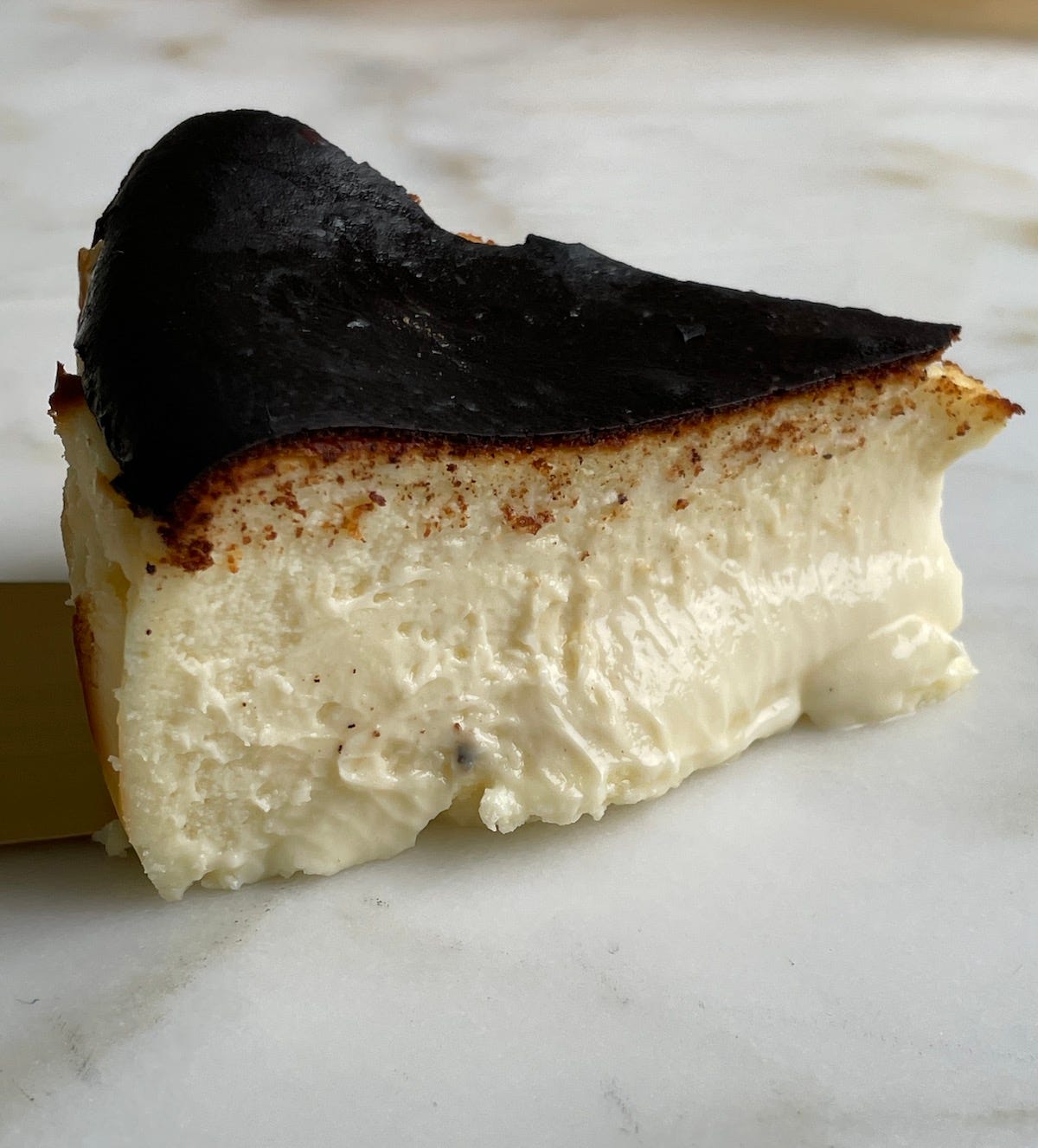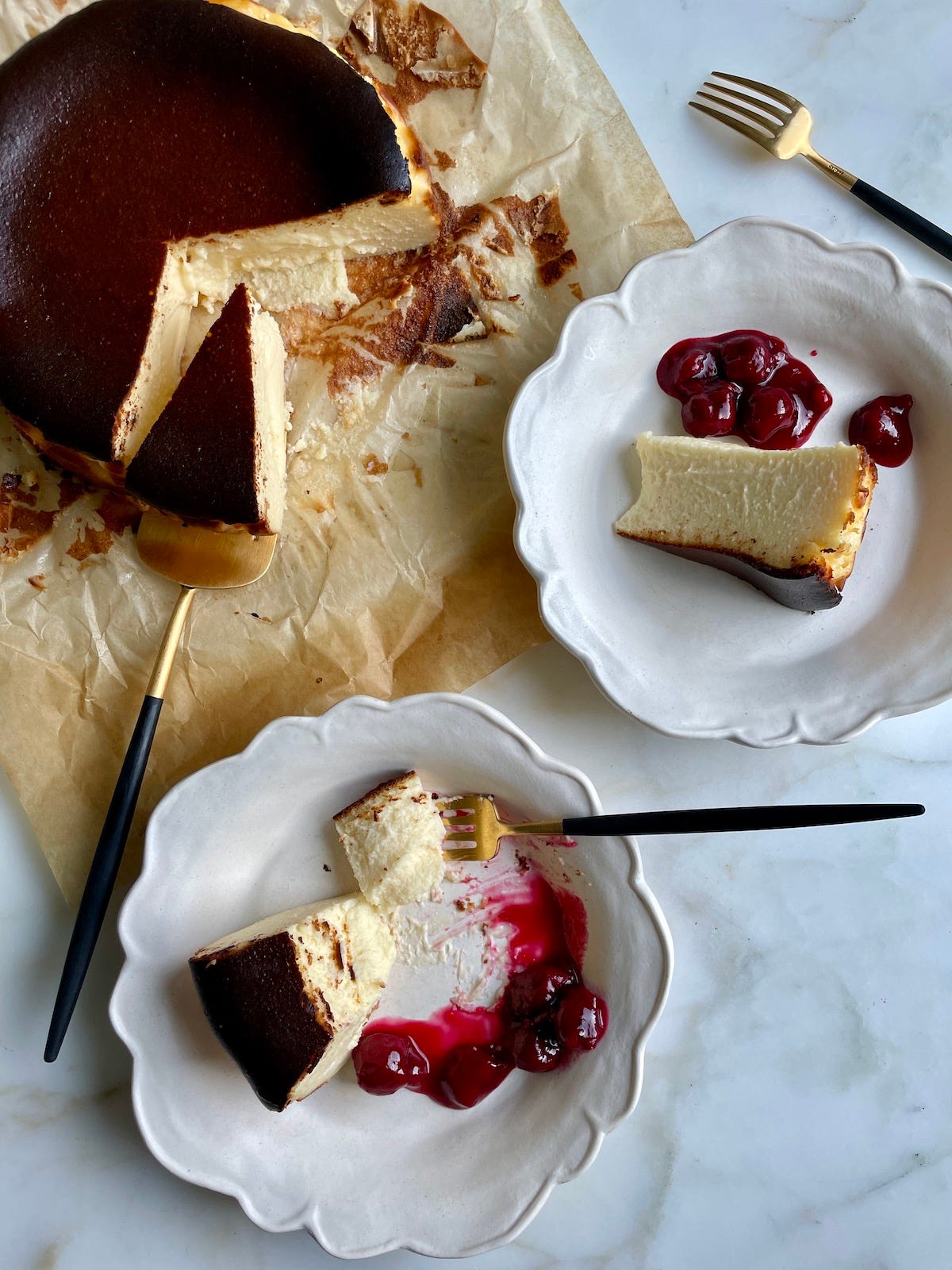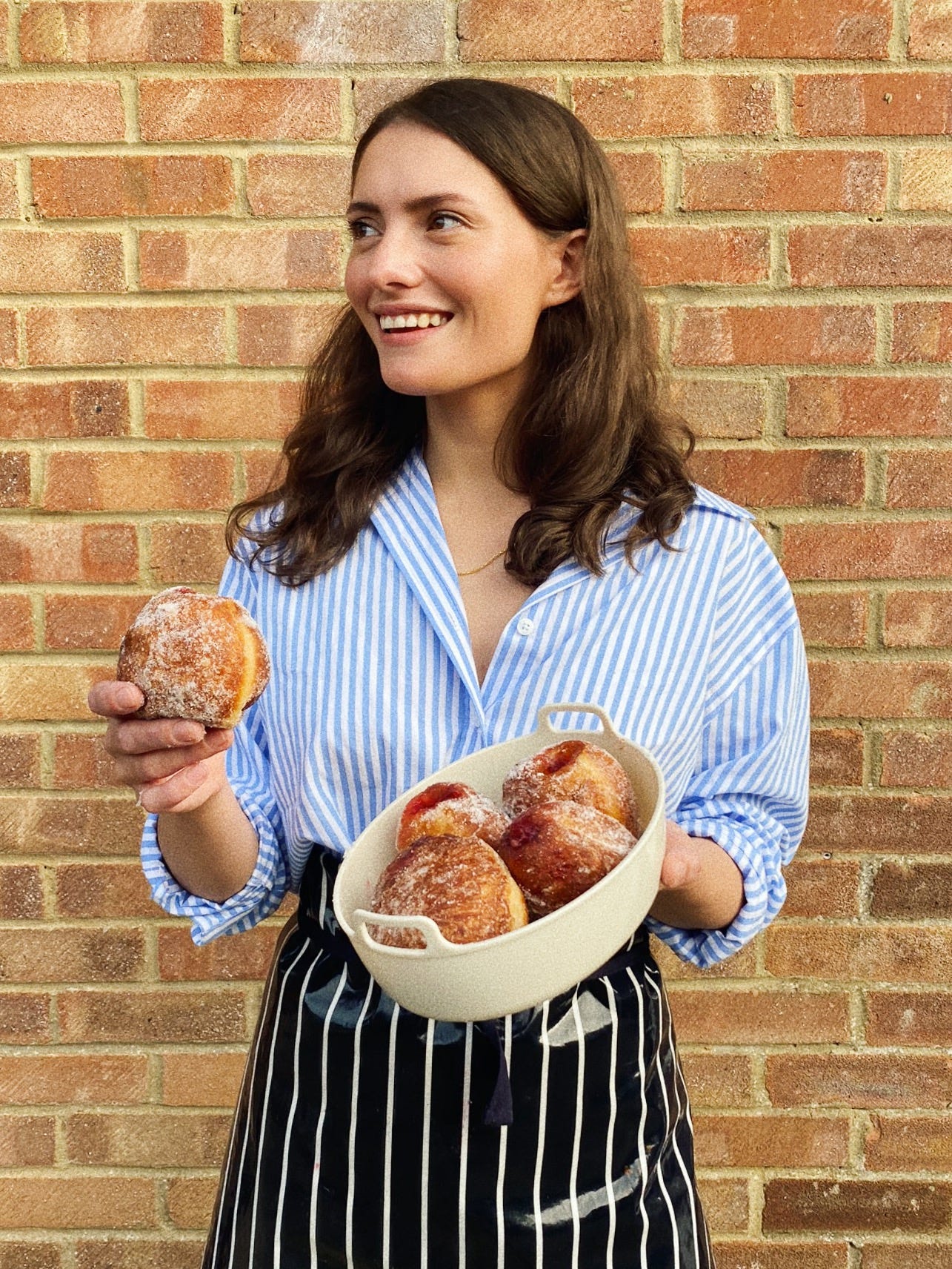Hi and welcome to Susanality, a newsletter by Susan Spungen that celebrates seasonal cooking. If you enjoy today’s recipes, please help spread the word by forwarding this email to others who may like them too!
One of the fun things about having a newsletter on Substack is that we writers have our own little community, and who doesn't need that? Every once in a while, I like to collaborate with another Substack writer and introduce you to someone I think you’ll like. Recently, I got to know Nicola Lamb who writes a newsletter called Kitchen Projects. Nicola is a London-based pastry chef who trained at Dominque Ansel, Ottolenghi, Little Bread Pedlar, and Happy Endings (an ice cream sandwich business). She’s now enjoying a vibrant freelance career writing her popular newsletter, consulting, and being, in her own words, a “pop-upper.” lark! Is Nicola’s pop-up, which pops up every few months at different locales around London.
Here’s Nicola’s description of lark! and how it came to be (there’s a pandemic pivot involved):
In 2020, I co-founded a pop-up, which then turned into an online pastry school during the pandemic - we had thousands of students, all baking along every week. That really ignited my love of teaching. Although that closed down at the end of the lockdown, I've been focusing on Kitchen Projects, which I feel is a new way to teach - in a world where 30-second videos are king, I love having a slower format - deep-diving is my jam.
In June 2021, I started lark!, which is really good fun. Every few months, I throw a pastry party (that's what I like to call them). It's a great way for me to collaborate with friends and people I love in the industry - the theme changes each time, but it's always hyper-seasonal. From picnic baskets in summer (lark! in the park!) to fruit pies in autumn (pie party with Verena Lochmuller, head of pastry development at Ottolenghi), it's fun to build and produce a brand new menu each time. This weekend's pop-up is all about summer fruits - [we are] going to be celebrating them in as many ways as possible. From fig leaf & melon baba, to peach mascarpone tarts, to panela & apricot cakes, I'm excited to showcase the best of British, European, & more tropical fruits.
And here’s a bit more about Nicola’s approach and philosophy:
When it comes to recipe development and the newsletter, I try to be infinitely curious and not afraid to fail - I just love the process of educating and teaching. I have taught classes in person, and they are a wonder, but I do love being able to reach lots of people in one go via the Sunday newsletter. I think so much of the process of 'making' or 'creating' is hidden behind closed doors, and so much of the food world, especially on IG and online, is seeing that 'perfect' final product - it's just not realistic! So, my hope is to involve as many people as possible in all of the fantastic trial and error and my hope is that Kitchen Projects will be a toolkit and field guide for anyone who is interested in baking. Knowledge is power, so I always hope I can help people feel more confident in their baking. That's the dream.
I love this approach and it’s what initially attracted me to Kitchen Projects. I’m guilty of presenting only the final, pretty, polished product. Especially when I was working on last December’s cookie recipes, I thought, “Hmmm, maybe it would be interesting to show the recipe development journey and the failures I had along the way.” I may still do that, but, for now, I direct you to Kitchen Projects. I know as readers and cooks, you want the final great recipe that you know is going to work, but there is something to be learned — especially when it comes to baking — from seeing the failures too. Or at least the subtle differences that a tweak of ingredients or techniques make.
When I was perusing Nicola’s archive looking for a recipe to share with you, it was an easy choice to go with Basque Cheesecake. I’ve been smitten (and curious) for a couple of years now since this creation first came to my attention, and I’d really been wanting to try one in my own kitchen. I recommend reading Nicola’s post, as well as this article from The Guardian to get a better understanding of the subtleties of this popular dessert before you step foot in the kitchen.
Basque cheesecake originated at La Viña, a restaurant in San Sebastián, Spain. They are famous for it, and sell many, many slices every day. While it’s kinda known here in the U.S., it’s more well known in London, where it has really become a THING. The fact that Brits often (and easily) travel to Spain is probably a factor in its popularity. Apparently, the trend has also been helped along by the restaurant BRAT, in Shoreditch, where almost everything, including the Basque cheesecake, comes out of the wood-burning oven.
That should tell you everything you need to know about this cheesecake, which is really quite simple to make and pretty hard to mess up. Unlike the cheesecakes Americans are used to, this one has no crust, and is cooked for a short time at a very high temperature, resulting in a cheesecake that firms up at the edges, turns anywhere from brown to almost black on top, but retains a very creamy center. Nicola has done extensive testing on this recipe, as she does with all of her recipes. She takes you on her recipe development journey, sharing the flops and failures along the way, not just the perfect final product. If you’re really into baking, there’s a lot you can learn about how things work and why they work from Kitchen Projects.
When I was in London in 2018, we were having dinner at Lyle’s, in Shoreditch, but I wanted to check out BRAT for a future meal, since it was just around the corner. I had heard good things, so we headed over for a peek after dinner. As we reached the top of a skinny staircase, the first thing I saw as we entered the bustling dining room was the Basque cheesecakes arrayed on a counter. On that particular night, since we were just quickly popping in, I didn’t have the time or the courage to snap a picture, but when we went back for dinner in January of 2020, just before the pandemic started, I made sure to take a picture of these gorgeous bronzed beauties on my way to our table.
I spent most of this past week baking Basque cheesecakes (FOUR in total), because, like Nicola, I like to perfect my bakes, and with something like a cake, there’s only one way to do it: Make the cake from beginning to end changing just one thing each time. I got slightly different results by playing around with the oven temps and baking times, but, truthfully, every single one was delicious. My first cake, which was baked at 500℉ for 25 to 30 minutes, was perhaps a bit too dark on top, so I moderated the temperature a bit and lengthened the bake time to achieve something deeply burnished on top but still very creamy in the center. That's the goal! If turning your oven to 475℉ in July sounds like a bad idea, keep in mind that it’s a short bake! And even if the top turns closer to black than mahogany brown, it tastes burnt only like a toasted marshmallow tastes burnt.


A Brief Hiatus
As I approach my deadline for the manuscript of my upcoming cookbook, I am putting Susanality on a month-long pause starting today. I have been juggling both over the last year or so, and, with my deadline nearly here, I need to put all my focus on the book for the next few weeks. (If you’re a paid subscriber and missed my Wednesday email, click here for the rundown on what to expect from a subscription standpoint!)
Check my archives for summer recipes in the meantime. Last July/early August I shared:
Spaghetti AOP (a bowl of pasta fit for Julia Roberts)
Quick Seafood Stew (pictured above!)
These would all be delicious and seasonal over the next few weeks, and I’ll be back in your inbox the week of August 8 with more fresh content! OK, now onto Nicola’s cheesecake…
Basque Cheesecake
By Nicola Lamb of Kitchen Projects
Makes 1 (8-inch) cheesecake
I did some testing of my own to adjust for the differences between American products and British products, not to mention ovens and oven temperatures, which are quite a bit different from ours. I’m giving the measurements in metric weights (grams) first, with the volume measurements, which are approximate, second. Hopefully you’re baking with a scale by now! It’s the easiest and most accurate way to bake. I fooled around with the baking temperature and time to achieve something close to Nicola’s final product. It’s important that the cream cheese and eggs are at room temperature. If they're cold, the cake will take longer to bake. Ir’s also worth noting that summer fruit is delicious paired with this cake!
600 g (21 ounces or 2 ¾ 8-ounce packages) cream cheese, at room temperature
200 g (1 cup) granulated sugar
200 g eggs (4 large), at room temperature
130 g sour cream (4 ½ ounces, a little more than 1/2 cup)
130 g heavy cream (4 ½ ounces, a little more than 1/2 cup)
25 g all-purpose flour (3 tablespoons)
6 g kosher salt (1 ¾ teaspoons)
Heat oven to 475℉. Line an 8-inch springform pan with a square of parchment paper. Fit the paper closely to the pan, making sure it extends an inch or two above the edge of the pan. Set aside.
In a stand mixer fitted with the paddle attachment, beat the cream cheese on medium speed until smooth. Gradually add the sugar, and beat until smooth and the sugar is dissolved. Feel a bit of the mixture between your fingers — there should be no grittiness.
Add the eggs one at a time, blending well and scraping down the sides of the bowl each time. Add the sour cream and heavy cream and beat briefly to combine smoothly.
Sift flour into a small bowl and add salt. In another separate bowl, combine some of the flour mixture and some of the cheesecake batter alternately, whisking all the while until smooth. You’ll use about 1 to 2 cups of the batter and all of the flour. (This step is to ensure there won’t be any lumps from adding the flour.) Add this mixture back into the cheesecake batter (in the mixer bowl), and beat briefly to combine. Remove the bowl from the mixer, give it one more good stir, scraping the bottom to make sure everything is thoroughly combined.
Scrape mixture into the prepared pan and tap to release any air bubbles. Place on a sheet pan and place in the center of the oven. Bake 35 to 40 minutes until browned on top. It will still look quite jiggly when gently shaken.
Remove from the oven and transfer to a cooling rack. When mostly cool, wrap in plastic and refrigerate overnight (and up to 2 days). Remove from the refrigerator about one hour before serving.
Serve with a glass of sherry, as is traditional, or with any kind of fresh fruit or cooked fruit compote.
Edited by Molly Ramsey











This is on my to-bake list! One of the best places we enjoyed it was at La Viña in San Sebastian. We ate there each day after tapas! One question and I think America's Test Kitchen had this in one of their cream cheese test comparisons...which brand of cream cheese? Many say traditional cheesecakes are better with Philadelphia Cream Cheese but just curious if a specific brand was used by Nicola/you.
Basque cheesecake has bee on my list to try for ages--since I pulled one of out F&W a couple summers ago. Can't wait to give this a go and good luck finishing this week, Susan!